
by Dr Manjir Samanta-Laughton | Jun 3, 2020 | Punk Science, Shakespeare
Have scientists found evidence of a parallel dimension in Antarctica? Recently a story went viral that scientists had found evidence of a parallel dimension in which time travels backwards.
So this is what we are looking at today on Punk Science TV: Mystery Neutrinos, Antarctica and Parallel dimensions
Code-named ANITA
NASA has an instrument – a high -altitude helium balloon fitted with Radio antennas. It’s a called ANITA and it’s designed to pick up the signature of the interaction of cosmic rays from space with the Earth.
And by 2016 two incidents of high energy cosmic rays were found but they were coming up from the Earth not down from space.
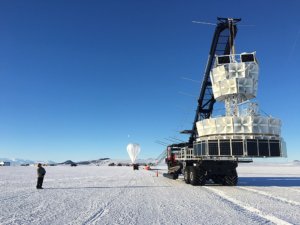
ANITA Helium balloon and instruments before deployment. Image: NASA Wiki commons
The Mystery Neutrinos
I am not a physicist but this is what I understand – there are many different types of particles including ones called neutrinos. There are some which interact very weakly. But the ones detected by ANITA in Antarctica are high energy neutrinos that actually have a wider cross-section so do bump into things.
This is why people are puzzled by what happened because for these particles to be detected by ANITA as coming out of the Earth, they would have to come down from space then back up from the Earth again.
And the physicists think that for these particles that would be impossible as they could not have made their way through the Earth through all that rock. That’s why this is such a big deal as it defies what we know about physics.
A radical solution
Neil Turok of The Perimeter Institute was reported by New Scientist as putting forward a radical solution. The particles coming up from the Earth are actually from a parallel dimension where time runs backwards. So in this model, the particles are really coming from space but we are seeing them coming up from the Earth as it is all running backwards.
That report in the media went viral.
What’s really happening?
But is there another explanation? I noticed that these types of particles have been detected before but that time they were traced to be coming from a black hole in the centre of a galaxy one that also sometimes gives off jets at the speed of light and gamma rays.
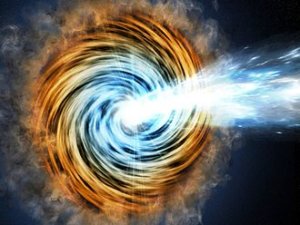
Image of Blazar – the source of high-energy neutrinos in space. Wiki commons
Hmm! So The Black Hole Principle says that every single aspect of the universe behaves in the same way only at different scales – from supermassive black holes to stars and even the Earth. So the centre of our planet should be capable of producing particles in a similar way to a galactic black hole.
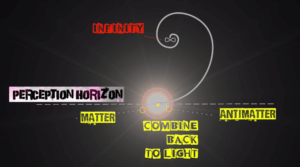
The Black Hole Principle
I even made a previous video about this some years ago. So according to the Black Hole Principle we expect cosmic rays to come from the Earth as at the centre of the Earth is a mini black hole dynamo doing much the same things as larger ones just smaller.
Problem solved!
Hope you enjoyed this episode of Punk Science TV. For more decoding of the universe follow and subscribe. ‘Till next time, thanks for watching.

by Dr Manjir Samanta-Laughton | May 27, 2020 | Punk Science, Science
Conventional Scientists believe that black holes burp on their food! In this episode of Punk Science TV, we explore this concept.
A Ridiculous idea
Scientists tend to think of people like myself as spouting a load of New Age spiritual nonsense. In some cases such as when the word ‘ quantum’ is bandied about amongst healers with no real mind to its actual context in physics, these accusations may have a case.
However, there are times, when mainstream scientists are the ones who come across as ridiculous. So in this example, we are discussing the concept of burping black holes.
The wrong monster
As you may know, the prevailing concept amongst mainstream scientists is that black holes are these great devouring monsters that tear apart stars and anything else that comes too close.
However, once the actual evidence began appearing, it became clear that black holes are visible because they are so bright and that also give off a lot of energy and material.
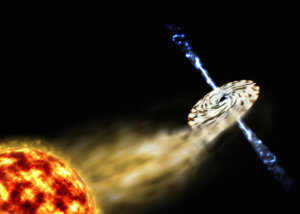
Old Picture of Black Holes, Shutterstock
Burp after the feast
Unable to give up their long-cherished notions that black holes are destructive monsters, these jets that are being emitted from black holes are then turned into ‘burps’.
The idea is that the black hole has feasted and then burps on its food.
This is lazy science.
The Projection game
Rather than realise that their concepts and theories do not match the evidence, they invent ‘burping’ black holes. Human characteristics are being projected onto objects in space as a way of coping with behaviour we don’t understand.
We understand that humans sometimes burp after eating a big meal so we have projected that onto black holes in order to avoid the thorny issue that, according to their own theories, nothing should escape a black hole.
Jets are predicted by The Black Hole Principle
Intermittent jets streaming from black holes are exactly what we would expect in The Black Hole Principle which says that black holes are creative.
We do not need to project any nonsensical ideas onto black holes if we understand that they are just a natural part of the universe unfolding.
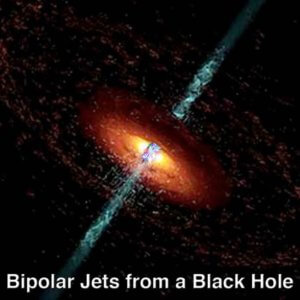

by Dr Manjir Samanta-Laughton | May 13, 2020 | Punk Science, Science, Simply Divine
A New Scientist article, published in May 2020 suggests that the whole universe may be Conscious.
The Hard Problem
Science still doesn’t understand how we can experience..anything!
It is sometimes called the hard problem of consciousness – how all these neurons and chemicals in our brain give rise to our inner experiences.
Now some Mathematicians think they have made a breakthrough.
We will be discussing the New Scientist article on this subject in this episode of Punk Science TV.
I’ve got IIT
This new, mathematical theory of consciousness is called Integrated Information theory or IIT.
It says that a system’s consciousness arises from the way information moves between subsystems.
You can see neurons as islands of subsystems.

According to this theory, consciousness appears when the information flow between these subsystems is complex enough to make the islands interdependent.
Changing the flow of information on one island affects all the others.
How well a system integrates information is given a value called phi.
The higher the phi the more consciousness a system will display.
An example of a situation in which this theory works well is when contrasting the cerebrum and cerebellum. Cerebral damage affects our consciousness more because it has a lot of connections – so its phi value is high.
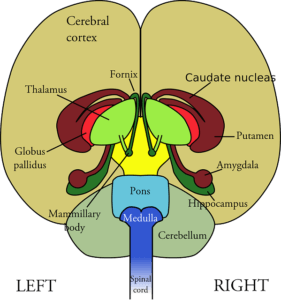
Pixabay
The Cerebellum isn’t so well connected, so damage doesn’t have as much effect on the conscious experience.
Problems
The theory has its drawbacks too.
- A major one is that the value of phi actually can increase in our sleep.
- It also still doesn’t explain our inner experiences, how does this theory explain our experience of the smell of coffee for example.
- Some inanimate systems have more consciousness than humans.

Usually, the concept of inanimate objects or even the whole universe having the property of consciousness is just dismissed but, in this article, they discuss that particles may have some sort of consciousness that is fundamental and human and animal consciousness emerges from this.
The Conscious Atom
The article goes onto consider whether even electrons are conscious and how this may explain the measurement problem in physics – how the wave function collapses with our measurement or observation.
So the idea that everything might be conscious and there is something fundamental about consciousness is being discussed in mainstream science.

This idea forms the basis of The Black Hole Principle – it is the reason why we can’t see light beyond light speed – because it is beyond our normal perception. Consciousness is written into the fabric of reality.
It’s good to see mainstream scientists also discuss these issues.

by Dr Manjir Samanta-Laughton | Apr 15, 2020 | Punk Science, Science
Five things you probably didn’t know about the Moon
Here are five mind-blowing facts you may not have realised about our closest neighbour
1. The Moon is flashing at us and we don’t know why
For many years now we have seen flashes on the Moon. They last between a few minutes to hours and we can’t predict them.
They have been spotted by amateur astronomers as well. Interestingly they do not seem to leave traces behind on the surface of the Moon.
Some speculate that these flashes could be associated with seismic activity but astronomers do not really know what they are.
Explanation: these flashes are created because the Moon also displays Black Hole Principle behaviour in that sometimes it creates light through the annihilation process of matter and antimatter.

The Black Hole Principle
2. A very dense anomaly has been detected under the South Pole of the moon.
As our ability to analyse bodies in space become more sophisticated, we have been able to scan the moon more deeply and found a few surprises. This has led to the finding of a very dense anomaly at the South Pole of the Moon. It could be some kind of very heavy metal and it’s 300 km beneath the surface. Our sense of the consistency of the moon has had to change.
Explanation: As discussed in previous articles on this site, it seems that many elements are generated by The Black Hole Principle, possibly all the elements. So this could be the reason why there is a dense anomaly 300 km beneath the surface of the Moon. It is being created by the centre of the Moon.
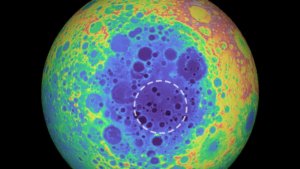
Image: © NASA/Goddard Space Flight Center/University of Arizona
3. The Moon contains water ice and could be producing it.
We used to think that the Moon was dry but now we know there is a lot of water there. It is especially around the poles and in craters as water ice.
Explanation: Water production is one of the hallmarks of The Black Hole Principle. We would expect water to be plentiful at the poles as The Black Hole Principle works in a bipolar jet fashion as seen at the galaxy level.
Moon craters then become a result of an upwelling force not impact. As the flow reaches the surface from the Moon’s core, water jets are formed, hence the ice found in the craters. So far there have been signs that mainstream scientists are realising that moons can have upwelling effects and explosions due to the crater dynamics but this is far from a generalised idea.
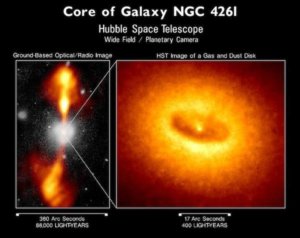
4. There could be active volcanoes on the moon.
Astronomers have detected signs of volcanic activity on the far side of the moon. We think there was some in the past but it could still be going on. We see volcanic activity on other moons in the solar system but this was also unexpected.
Explanation: Volcanic activity is also the periodic release of energy from beyond the speed of light from the inner black hole dynamo of each planet of each moon.
5. The moon is brighter than the sun in the gamma-ray spectrum.
We now have different telescopes in use that look at different parts of the electromagnetic spectrum. This has revealed to us that the Moon is actually brighter than the sun in the gamma-ray spectrum.
Explanation: Of course, the mainstream scientists will say that the gamma rays are only just hitting the moon from outside, but according to The Black Hole Principle, it is perfectly possible for the Moon to be creating gamma rays itself.
I hope you have enjoyed our exploration of the Moon. Are there any facts that we have missed out? Which new revelations have interested you the most? Please leave a comment below this article.

by Dr Manjir Samanta-Laughton | Mar 25, 2020 | Punk Science, Science
Where did the Water of the Earth come from?
The Earth is almost covered with water, but it may surprise you that scientists are still debating as to how all this water got here in the first place. The general consensus is that water arrived originally on this planet via an impact collision with a comet or asteroid. Analysis of comets and asteroids in space have shown that the type of water they contain is not always an exact match.
The real answer is that we don’t know for sure the answer to this pretty basic question.
Finding the Solution
According to the Black Hole Principle, each and every celestial body from stars to planets to comets has the ability to create its own water from its centre. In this way, they follow the pattern laid out for everything from supermassive black holes to thunderstorms.
The Ocean beneath us
The Earth is no different. In 2013, I gave a keynote lecture at the Institute of Noetic Sciences in which I predicted that the water of the Earth is actually being produced by its interior. In just a few months, scientists announced to the world that an ‘ocean’ had been found deep below the Earth’s surface.
It is water bound up in rocks and crystals but nevertheless represents more water than exists on the Earth’s surface.
The Simple Pattern
Once you know The Black Hole Principle, you can easily make such predictions about the universe because you understand the simple underlying pattern throughout reality.
Therefore we have solved the questions of where Earth’s water has come from – it is being produced by the Earth itself.



















